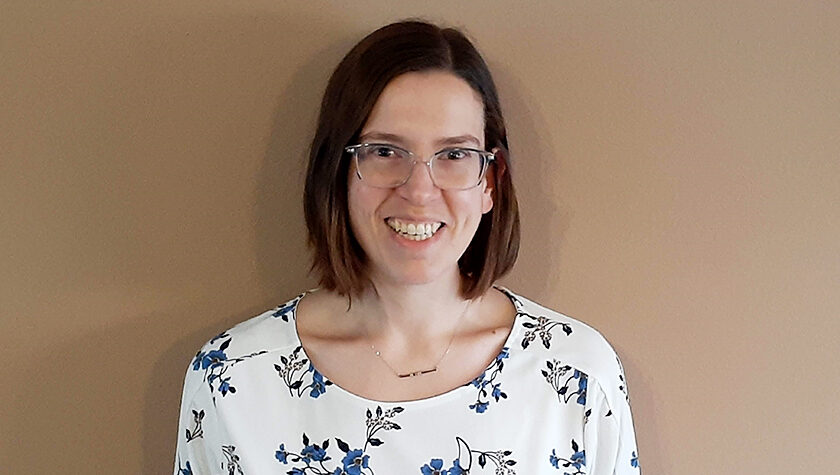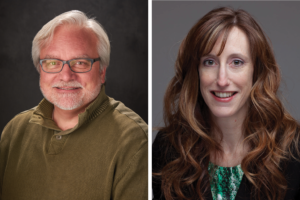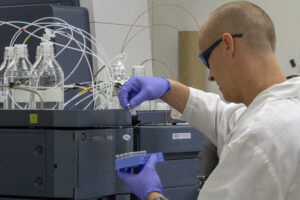
7
June

In a joint role, Heather Barkholtz joins the School of Pharmacy and the Wisconsin State Laboratory of Hygiene
By Katie Ginder-Vogel
A new faculty position at the University of Wisconsin–Madison School of Pharmacy is set to expand the School’s expertise in toxicology and enhance its relationship with the Wisconsin State Laboratory of Hygiene (WSLH), the state’s public health laboratory and a part of UW–Madison.
In a joint role with the WSLH, Heather Barkholtz is joining the School of Pharmacy’s Pharmaceutical Sciences Division as an assistant professor, bringing a focus on surveillance for drugs of abuse, such as cannabinoids and psychoactive drugs.
“Through her joint appointment, Dr. Barkholtz will serve as an important bridge linking the research expertise of our School’s faculty and staff and the cutting-edge analytical capabilities of the WSLH with its state-of-the-art equipment and expert scientists,” said School of Pharmacy Dean Steve Swanson. “She is a chemist with a transdisciplinary background in chemistry, nanotechnology, materials science, and forensic toxicology.”
“Through her joint appointment, Dr. Barkholtz will serve as an important bridge linking the research expertise of our School’s faculty and staff and the cutting-edge analytical capabilities of the WSLH with its state-of-the-art equipment and expert scientists.”
—Steve Swanson
Barkholtz’s faculty position enhances collaboration between the WSLH and the School of Pharmacy to advance innovation in opioid and drug abuse surveillance and foster translational research, teaching, and outreach that support public health surveillance and testing.
“The Hygiene Lab has state-of-the-art forensic toxicology instrumentation and expert clinicians, and the School of Pharmacy has a world-class drug discovery and drug action research program,” says Barkholtz. “I hope to bring elements from both arms together for a complementary approach to drugs of abuse.”
Drug surveillance research
Barkholtz holds a bachelor’s degree in chemistry from UW–Oshkosh, a PhD in chemistry with an emphasis in nanotechnology from Northern Illinois University, and conducted a postdoctoral fellowship at Sandia National Labs in Albuquerque, New Mexico. For the past four years, she has served as the chief of the Chemical Testing Section in the Wisconsin Department of Transportation Division of State Patrol.

“I plan to use my analytical chemistry background to develop and validate novel techniques to detect drugs of abuse,” says Barkholtz. Her research at the WSLH will focus on developing tools that toxicologists and first responders can use to recognize and understand a wider swath of cannabinoids and synthetic drugs, as well as creating new ways to detect which drugs may have been ingested.
“My research in the Division of State Patrol gave me a great lens for first responders’ perspectives, and there are gaps in the tools they have at the roadside to help people,” she says. “To close that gap, I’m hoping to scope the prevalence and action of cannabinoids beyond delta-9-THC and CBD.”
Barkholtz also plans to look at novel psychoactive substances. When new synthetic drugs appear on the street, there is no analytical data, standards, or studies about their adverse effects, which is a major challenge to toxicologists, she says.
“I’d like to start to predict what drugs are likely to emerge and generate spectral signatures of those compounds and preliminary computational estimates of their toxicity,” Barkholtz says, which will serve as tools for toxicologists to identify the substances.
Barkholtz’s third area of focus is on alternative matrices for drug detection, initially focusing on oral fluid.
“We could equip first responders with tools to detect what substance might be causing or contributing to a situation,” says Barkholtz. “That will help inform actions, even if it’s at the hospital — they’d have more information about how to process the patient clinically, which will improve patient outcomes.”
Enhancing collaboration and education
Barkholtz’s arrival at the School augments faculty expertise in toxicology and provides School of Pharmacy faculty greater access to the WSLH’s high-end analytical equipment, says Jeff Johnson, a professor in the School’s Pharmaceutical Sciences Division, who co-chaired the search committee with WSLH Forensic Toxicology Director Amy Miles.

“This position allows her to have protected time to do research,” says Johnson. About a third of Barkholtz’s time will be spent working for the WSLH, and the rest will be associated with the School of Pharmacy, teaching and developing an independent research program.
Barkholtz’s position is Miles’ brainchild, and Miles is excited about the research partnership.
“We’re one of leading forensic toxicology labs in the country, and now we have a mechanism to do true research,” said Miles. “I’ve always wanted to apply for funding for a forensic toxicology center of excellence but didn’t have the right academic resource. Now, through the relationship we’re building with the School of Pharmacy, we can talk about housing a center of excellence here at UW–Madison.”
Miles is also anticipating new continuing education opportunities in forensic toxicology for her staff at WSLH that could be met by courses through the School of Pharmacy.
“We testify in court and are always looking to advance our knowledge,” says Miles. “Research and continuing education support for our mission is an incredible resource.”
Johnson has identified teaching opportunities for Barkholtz in the School’s Pharmacology and Toxicology (PharmTox) bachelor’s degree program, which he directs, and other possibilities within the Molecular and Environmental Toxicology Center (M&ENVTOX).
“I find collaborative research and teaching invigorating, and the Hygiene Lab and the School of Pharmacy are hubs of collaboration that bring together diverse perspectives and expertise.”
—Heather Barkholtz
“All undergraduate students in the School’s PharmTox program take M&ENVTOX courses, so she’d contribute to the School of Pharmacy that way,” says Johnson. “I’m planning for her to teach a lab section of my fall PharmTox course so she can meet the first-semester PharmTox students in a lab setting and engage them in research.”
Since part of the PharmTox major requires wet bench research, Barkholtz’s lab also serves as an opportunity for student researchers. Barkholtz is ready.
“I find collaborative research and teaching invigorating, and the Hygiene Lab and the School of Pharmacy are hubs of collaboration that bring together diverse perspectives and expertise,” says Barkholtz. “I’m excited to contribute to the field of forensic toxicology, both through research and through training toxicology students.”




